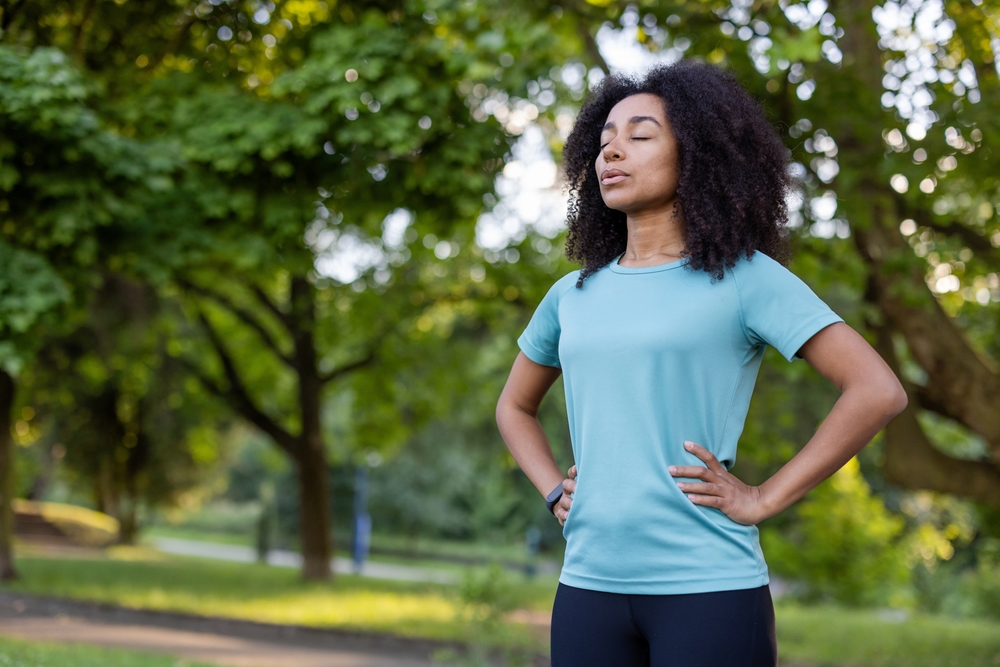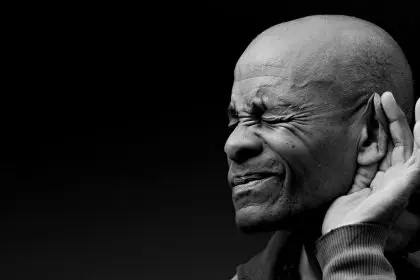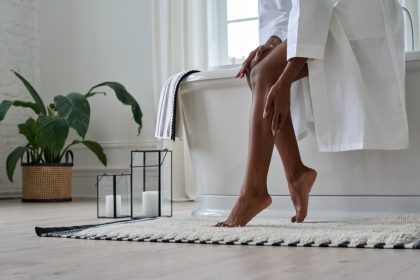That mysterious tightness in your hips isn’t just from sitting too long at your desk. For many women, the hip region serves as an emotional storage locker, holding onto stress, trauma, and tension in ways that most of us never consciously realize. The phrase “hips don’t lie” takes on an entirely new meaning when you understand how this powerful area of the female body bears the weight of both physical and psychological burdens.
The emotional vault
Women’s bodies respond to stress differently than men’s, with fascinating patterns in where and how tension gets stored. While men often carry stress in their shoulders and jaw, women frequently pack it into their hips—creating a physical vault for emotional experiences that haven’t been fully processed or released.
This isn’t just New Age talk. The hip region contains the body’s largest group of muscles, including the psoas—a deep core muscle connecting your spine to your legs that physiologists sometimes call “the emotional muscle” because of how sensitively it responds to psychological stress. When you feel threatened or anxious, this muscle instinctively contracts as part of your body’s protective response.
For women, whose bodies evolved with childbearing capability, the hip region carries additional biological significance. The female pelvis literally creates space for new life, but this same openness also makes it vulnerable to holding tension from life’s challenges and pressures.
The fight-or-flight freezer
When your body enters fight-or-flight mode during stressful situations, your muscles tense up, ready for action. But in modern life, we rarely physically fight or flee—instead, we sit through tense meetings, swallow our words during difficult conversations, or push through emotional discomfort without moving our bodies.
Without physical release, that stress response gets trapped in your tissues. For women, the hip region becomes a primary storage depot for this unresolved tension. Each time you experience stress without physical release, layers of tension accumulate in these muscles, creating what some bodyworkers describe as “emotional sediment.”
This pattern becomes particularly pronounced in women because of both biological and social factors. The female stress response more often involves a “tend and befriend” component alongside fight-or-flight, creating complex muscle patterns that frequently center in the pelvis and hips—the literal core of female anatomy and symbolic center of feminine energy in many cultural traditions.
The trauma container
Beyond everyday stress, more significant emotional experiences like grief, heartbreak, or trauma often take up residence specifically in female hips. This pattern appears across cultures and throughout history, with traditional healing practices from various regions recognizing the connection between women’s emotional well-being and hip mobility.
The hip area surrounds reproductive organs and contains nerve pathways connected to your pelvis, making it particularly responsive to experiences involving safety, sexuality, and vulnerability. When those experiences involve trauma or violation, the body often responds by creating tension in this region—a physical armor attempting to protect vulnerable areas.
Many women report feeling unexpected emotional releases during hip-opening yoga poses or massage therapy targeting the hip region. These releases can manifest as spontaneous tears, memory flashes, or sudden emotional insights that seem to come from nowhere. What’s actually happening is the unlocking of emotional content that’s been physically stored in these tissues, sometimes for years.
The postural feedback loop
Your mental state affects your posture, but the reverse is equally true—how you hold your body influences your emotional experience. Chronically tight hips create a physical posture that reinforces certain emotional states, creating a feedback loop between body and mind.
When hips become restricted, the body compensates by adjusting surrounding structures. Your lower back might arch excessively, your glutes might become underactive, or your knees might rotate inward. These changes don’t just create physical discomfort—they literally shape how confidently you move through the world.
This physical arrangement can subtly reinforce feelings of vulnerability or defensiveness. Walking with tight, restricted hips creates a less grounded, less powerful movement pattern. Over time, this restricted physical expression can reinforce emotional patterns of hesitation or self-protection, making it harder to break free from limiting beliefs or behaviors.
The feminine archetypes
Across cultures, the hip region has been associated with specifically feminine power and expression. From belly dancers to traditional African dance forms, movement traditions worldwide have recognized the hips as a center of female creative energy, emotional expression, and personal power.
Modern life offers fewer opportunities for women to move their hips freely and expressively. Many common exercise forms—from running to weight lifting—emphasize forward movement or isolated muscle contractions rather than the fluid, circular hip movements found in traditional dance forms.
This cultural shift away from hip-centric movement coincides with increasing reports of hip tension among women. Without regular expressive movement through this region, the natural release of emotional tension becomes less available, allowing stress to accumulate more readily in these already vulnerable tissues.
The biological predisposition
Female anatomy creates specific vulnerabilities in the hip region that men simply don’t share. Women’s wider pelvises, designed to accommodate childbirth, create different muscle attachments and biomechanical patterns. The resulting structure, while perfect for its evolutionary purpose, creates more complex muscular relationships that can more easily harbor tension.
Hormonal fluctuations throughout the menstrual cycle also influence ligament laxity and muscle tension in the pelvic region. During certain phases, tissues in this area become more pliable and responsive to both physical and emotional inputs, potentially increasing their susceptibility to storing stress-related tension.
This biological reality isn’t a design flaw but a design feature—one that historically connected women deeply to their bodies’ rhythms and wisdom. Yet in our disconnected modern context, these same biological patterns can create challenges when not properly understood and addressed.
The release revelation
The fascinating flip side of hips as stress storage is their potential for emotional release and healing. When women consciously work with hip tension through movement, massage, or mindful stretching, they often experience profound emotional shifts alongside physical relief.
This connection explains why hip-opening yoga poses often trigger unexpected emotional responses. Postures like pigeon pose, goddess squat, or reclining bound angle create space in precisely the areas where women tend to pack away stress and difficult emotions.
The release isn’t just physical—it’s a genuine emotional unburdening. Many women report feeling lighter, more emotionally clear, and more connected to themselves after practices focused on hip opening. This isn’t coincidental but reflects the genuine mind-body connection centered in this powerful region.
The intuitive intelligence
Perhaps most fascinating is how hip tension often reflects specific emotional patterns unique to each woman’s experience. Different emotional histories create different tension patterns—the hip tightness from chronic anxiety feels and manifests differently than the tightness stemming from grief or heartbreak.
Some bodywork practitioners suggest that the body exhibits an intuitive intelligence, storing related emotional experiences in specific tissues. This “somatic memory” creates patterns that trained practitioners can sometimes identify through touch and movement assessment.
While individual experiences vary widely, common patterns emerge. Tension in the outer hips often correlates with boundary issues and self-protection impulses. Inner thigh and groin tension frequently relates to vulnerability and trust challenges. Lower buttock and tailbone tension commonly connects to feelings of being unsupported or unsafe.
The practical approach
Understanding the hip-stress connection opens doors to more effective self-care strategies. Rather than treating hip tension as merely a physical nuisance, women can approach it as a meaningful conversation with their bodies about their emotional well-being.
Simple practices can make profound differences. Daily hip-opening stretches, especially before bed, help prevent stress accumulation. Conscious movement practices like yoga, dance, or tai chi create opportunities for both preventing and releasing hip-centered tension.
Perhaps most importantly, bringing awareness to the hip region during stressful moments can interrupt the storage pattern. Simply noticing when your hips tighten during challenging situations allows you to consciously release tension instead of packing it away for later.
The cultural context
Our culture rarely acknowledges this mind-body connection explicitly, leaving many women confused about why hip tension seems so emotionally charged. The separation of physical symptoms from emotional causes creates unnecessary suffering and prevents integrated healing.
Some cultural traditions have maintained this wisdom. Various indigenous healing practices recognize the hip region as an emotional center requiring specific attention for women’s wellbeing. Traditional Chinese Medicine maps emotional states to specific meridians running through the hip area, creating sophisticated understanding of these connections.
By reclaiming this body wisdom, modern women can develop more intuitive, effective approaches to both emotional and physical wellness. The hip region becomes not just a problem area but a resource for greater self-understanding and emotional resilience.
The liberation potential
Perhaps most exciting is how working with hip tension can create not just relief but genuine transformation. As women release long-held tensions in this area, they often experience shifts in how they move through the world—not just physically but emotionally and relationally.
The hips directly influence your sense of personal power, affecting everything from how confidently you walk into a room to how freely you express yourself. When this area becomes less constricted, many women report feeling more authentic, more assertive, and more comfortable in their own skin.
This physical-emotional liberation creates ripple effects through all aspects of life. Relationships shift as old protective patterns release. Creative expression expands as energy flows more freely. Even professional presence can transform as the body communicates more confidence and groundedness.
By understanding and working with the unique ways your body holds and processes stress, you gain access to healing possibilities that transcend the limitations of purely mental or purely physical approaches. Your hips aren’t just causing discomfort—they’re offering a pathway to deeper self-knowledge and more integrated wellbeing.















